Financial Accounting Report: Financial Statement Analysis and Users
VerifiedAdded on 2020/01/06
|23
|5057
|163
Report
AI Summary
This report delves into the realm of financial accounting, focusing on the analysis and reporting of financial transactions for EL Ltd., a company providing electrical services. It examines the diverse needs of various financial statement users, including managers, employees, owners, investors, lenders, suppliers, and government agencies, and how they utilize financial information for decision-making. The report explores the legal and regulatory influences on financial statements, such as the Companies Act 2006, UK GAAP, and International Accounting Standards (IAS/IFRS), and their implications for users. It covers the preparation of financial statements from both complete and incomplete records, including the preparation of a consolidated balance sheet and profit and loss account. Additionally, it includes the calculation of accounting ratios for assessing performance and the incorporation and interpretation of financial performance through comparative analysis. The report aims to provide a comprehensive understanding of financial accounting principles and practices.
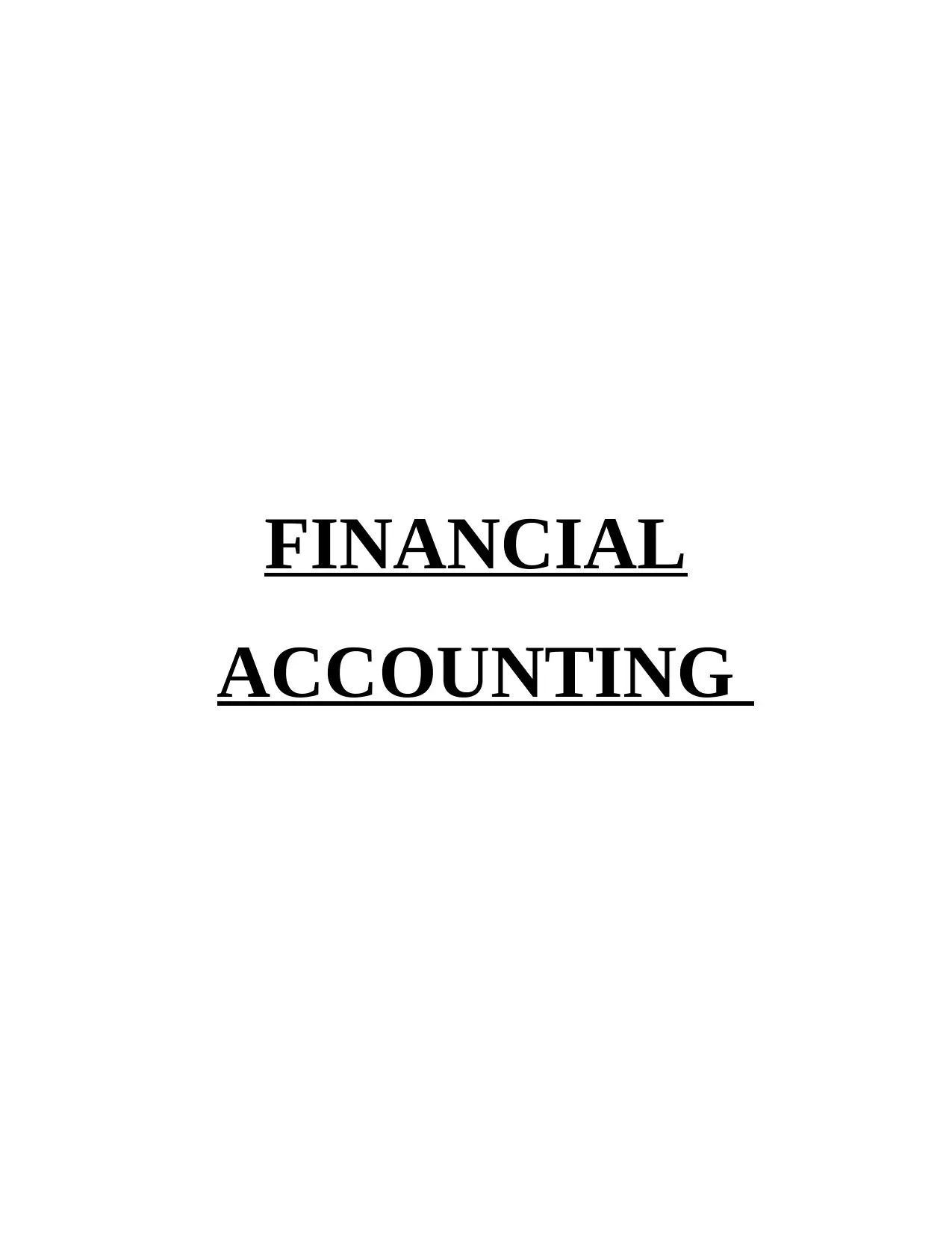
FINANCIAL
ACCOUNTING
ACCOUNTING
Paraphrase This Document
Need a fresh take? Get an instant paraphrase of this document with our AI Paraphraser
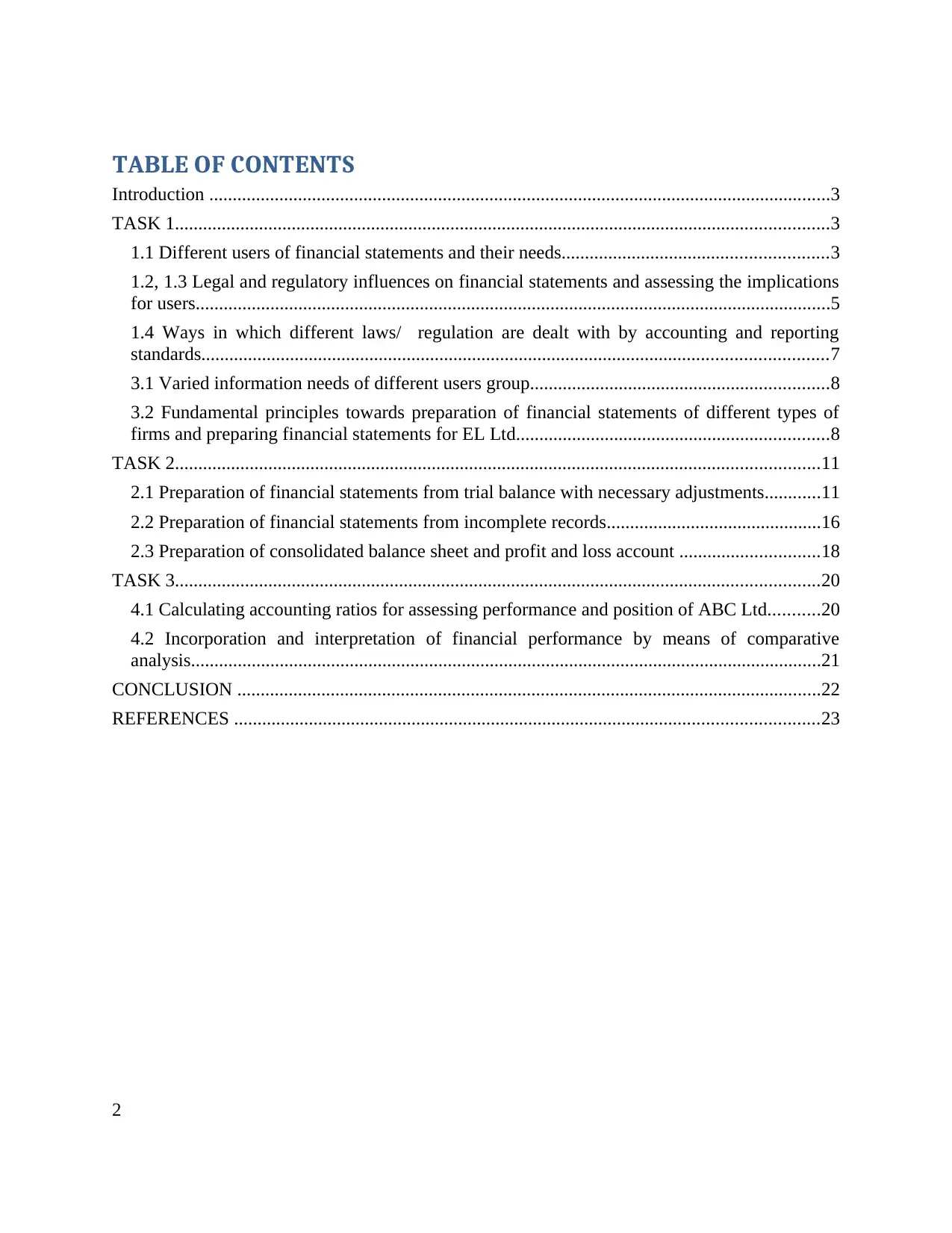
TABLE OF CONTENTS
Introduction .....................................................................................................................................3
TASK 1............................................................................................................................................3
1.1 Different users of financial statements and their needs.........................................................3
1.2, 1.3 Legal and regulatory influences on financial statements and assessing the implications
for users........................................................................................................................................5
1.4 Ways in which different laws/ regulation are dealt with by accounting and reporting
standards......................................................................................................................................7
3.1 Varied information needs of different users group................................................................8
3.2 Fundamental principles towards preparation of financial statements of different types of
firms and preparing financial statements for EL Ltd...................................................................8
TASK 2..........................................................................................................................................11
2.1 Preparation of financial statements from trial balance with necessary adjustments............11
2.2 Preparation of financial statements from incomplete records..............................................16
2.3 Preparation of consolidated balance sheet and profit and loss account ..............................18
TASK 3..........................................................................................................................................20
4.1 Calculating accounting ratios for assessing performance and position of ABC Ltd...........20
4.2 Incorporation and interpretation of financial performance by means of comparative
analysis.......................................................................................................................................21
CONCLUSION .............................................................................................................................22
REFERENCES .............................................................................................................................23
2
Introduction .....................................................................................................................................3
TASK 1............................................................................................................................................3
1.1 Different users of financial statements and their needs.........................................................3
1.2, 1.3 Legal and regulatory influences on financial statements and assessing the implications
for users........................................................................................................................................5
1.4 Ways in which different laws/ regulation are dealt with by accounting and reporting
standards......................................................................................................................................7
3.1 Varied information needs of different users group................................................................8
3.2 Fundamental principles towards preparation of financial statements of different types of
firms and preparing financial statements for EL Ltd...................................................................8
TASK 2..........................................................................................................................................11
2.1 Preparation of financial statements from trial balance with necessary adjustments............11
2.2 Preparation of financial statements from incomplete records..............................................16
2.3 Preparation of consolidated balance sheet and profit and loss account ..............................18
TASK 3..........................................................................................................................................20
4.1 Calculating accounting ratios for assessing performance and position of ABC Ltd...........20
4.2 Incorporation and interpretation of financial performance by means of comparative
analysis.......................................................................................................................................21
CONCLUSION .............................................................................................................................22
REFERENCES .............................................................................................................................23
2
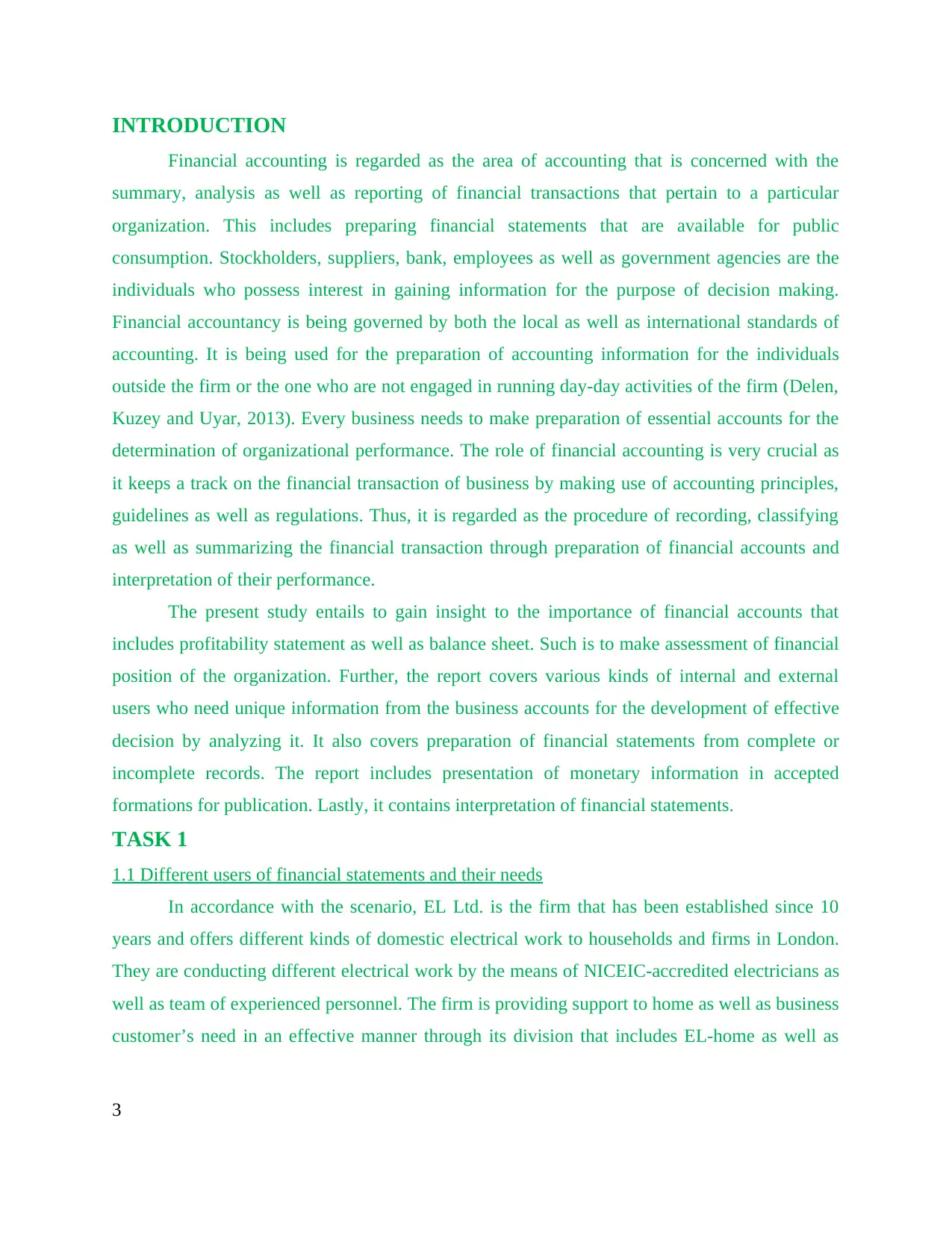
INTRODUCTION
Financial accounting is regarded as the area of accounting that is concerned with the
summary, analysis as well as reporting of financial transactions that pertain to a particular
organization. This includes preparing financial statements that are available for public
consumption. Stockholders, suppliers, bank, employees as well as government agencies are the
individuals who possess interest in gaining information for the purpose of decision making.
Financial accountancy is being governed by both the local as well as international standards of
accounting. It is being used for the preparation of accounting information for the individuals
outside the firm or the one who are not engaged in running day-day activities of the firm (Delen,
Kuzey and Uyar, 2013). Every business needs to make preparation of essential accounts for the
determination of organizational performance. The role of financial accounting is very crucial as
it keeps a track on the financial transaction of business by making use of accounting principles,
guidelines as well as regulations. Thus, it is regarded as the procedure of recording, classifying
as well as summarizing the financial transaction through preparation of financial accounts and
interpretation of their performance.
The present study entails to gain insight to the importance of financial accounts that
includes profitability statement as well as balance sheet. Such is to make assessment of financial
position of the organization. Further, the report covers various kinds of internal and external
users who need unique information from the business accounts for the development of effective
decision by analyzing it. It also covers preparation of financial statements from complete or
incomplete records. The report includes presentation of monetary information in accepted
formations for publication. Lastly, it contains interpretation of financial statements.
TASK 1
1.1 Different users of financial statements and their needs
In accordance with the scenario, EL Ltd. is the firm that has been established since 10
years and offers different kinds of domestic electrical work to households and firms in London.
They are conducting different electrical work by the means of NICEIC-accredited electricians as
well as team of experienced personnel. The firm is providing support to home as well as business
customer’s need in an effective manner through its division that includes EL-home as well as
3
Financial accounting is regarded as the area of accounting that is concerned with the
summary, analysis as well as reporting of financial transactions that pertain to a particular
organization. This includes preparing financial statements that are available for public
consumption. Stockholders, suppliers, bank, employees as well as government agencies are the
individuals who possess interest in gaining information for the purpose of decision making.
Financial accountancy is being governed by both the local as well as international standards of
accounting. It is being used for the preparation of accounting information for the individuals
outside the firm or the one who are not engaged in running day-day activities of the firm (Delen,
Kuzey and Uyar, 2013). Every business needs to make preparation of essential accounts for the
determination of organizational performance. The role of financial accounting is very crucial as
it keeps a track on the financial transaction of business by making use of accounting principles,
guidelines as well as regulations. Thus, it is regarded as the procedure of recording, classifying
as well as summarizing the financial transaction through preparation of financial accounts and
interpretation of their performance.
The present study entails to gain insight to the importance of financial accounts that
includes profitability statement as well as balance sheet. Such is to make assessment of financial
position of the organization. Further, the report covers various kinds of internal and external
users who need unique information from the business accounts for the development of effective
decision by analyzing it. It also covers preparation of financial statements from complete or
incomplete records. The report includes presentation of monetary information in accepted
formations for publication. Lastly, it contains interpretation of financial statements.
TASK 1
1.1 Different users of financial statements and their needs
In accordance with the scenario, EL Ltd. is the firm that has been established since 10
years and offers different kinds of domestic electrical work to households and firms in London.
They are conducting different electrical work by the means of NICEIC-accredited electricians as
well as team of experienced personnel. The firm is providing support to home as well as business
customer’s need in an effective manner through its division that includes EL-home as well as
3
⊘ This is a preview!⊘
Do you want full access?
Subscribe today to unlock all pages.

Trusted by 1+ million students worldwide
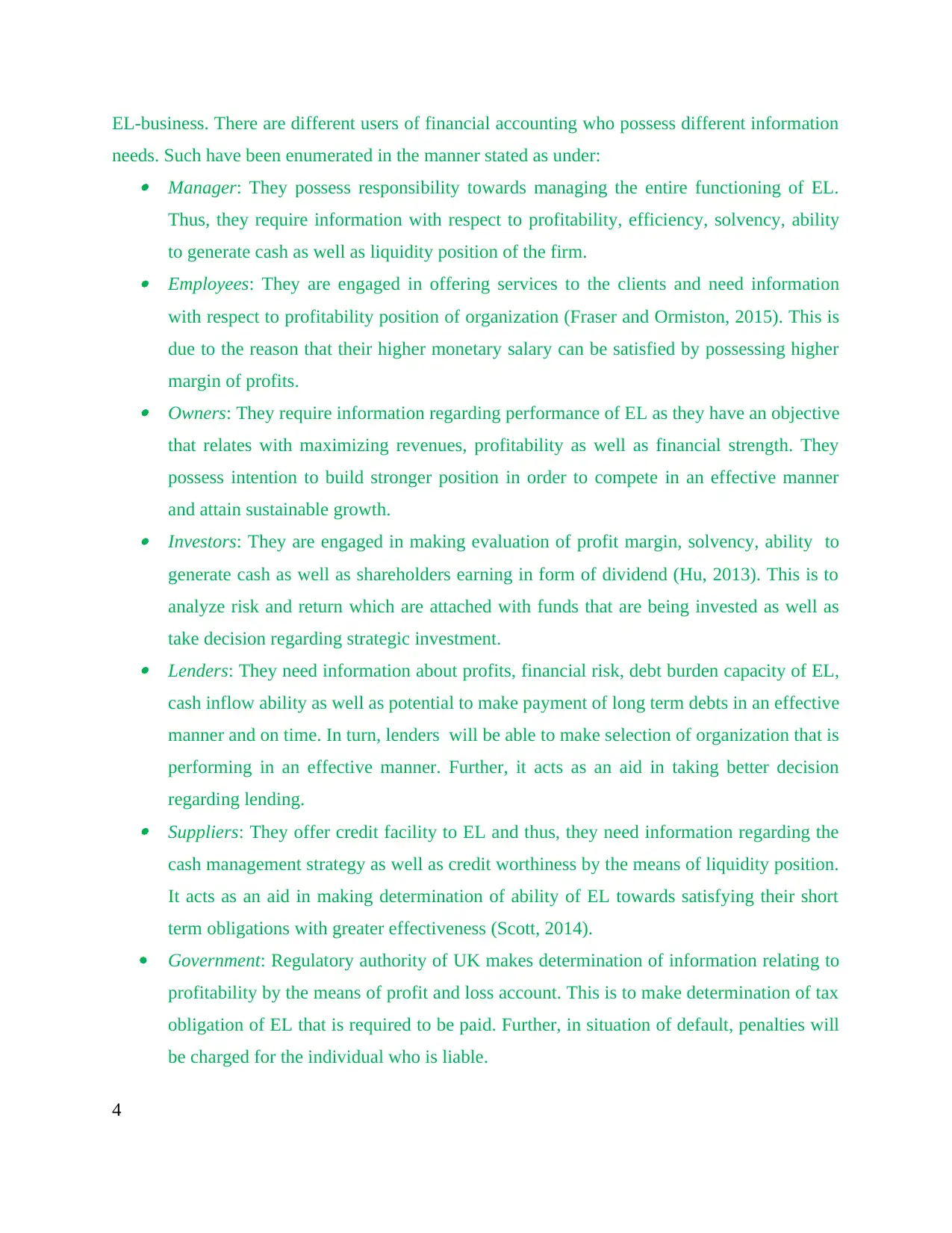
EL-business. There are different users of financial accounting who possess different information
needs. Such have been enumerated in the manner stated as under: Manager: They possess responsibility towards managing the entire functioning of EL.
Thus, they require information with respect to profitability, efficiency, solvency, ability
to generate cash as well as liquidity position of the firm. Employees: They are engaged in offering services to the clients and need information
with respect to profitability position of organization (Fraser and Ormiston, 2015). This is
due to the reason that their higher monetary salary can be satisfied by possessing higher
margin of profits. Owners: They require information regarding performance of EL as they have an objective
that relates with maximizing revenues, profitability as well as financial strength. They
possess intention to build stronger position in order to compete in an effective manner
and attain sustainable growth. Investors: They are engaged in making evaluation of profit margin, solvency, ability to
generate cash as well as shareholders earning in form of dividend (Hu, 2013). This is to
analyze risk and return which are attached with funds that are being invested as well as
take decision regarding strategic investment. Lenders: They need information about profits, financial risk, debt burden capacity of EL,
cash inflow ability as well as potential to make payment of long term debts in an effective
manner and on time. In turn, lenders will be able to make selection of organization that is
performing in an effective manner. Further, it acts as an aid in taking better decision
regarding lending. Suppliers: They offer credit facility to EL and thus, they need information regarding the
cash management strategy as well as credit worthiness by the means of liquidity position.
It acts as an aid in making determination of ability of EL towards satisfying their short
term obligations with greater effectiveness (Scott, 2014).
Government: Regulatory authority of UK makes determination of information relating to
profitability by the means of profit and loss account. This is to make determination of tax
obligation of EL that is required to be paid. Further, in situation of default, penalties will
be charged for the individual who is liable.
4
needs. Such have been enumerated in the manner stated as under: Manager: They possess responsibility towards managing the entire functioning of EL.
Thus, they require information with respect to profitability, efficiency, solvency, ability
to generate cash as well as liquidity position of the firm. Employees: They are engaged in offering services to the clients and need information
with respect to profitability position of organization (Fraser and Ormiston, 2015). This is
due to the reason that their higher monetary salary can be satisfied by possessing higher
margin of profits. Owners: They require information regarding performance of EL as they have an objective
that relates with maximizing revenues, profitability as well as financial strength. They
possess intention to build stronger position in order to compete in an effective manner
and attain sustainable growth. Investors: They are engaged in making evaluation of profit margin, solvency, ability to
generate cash as well as shareholders earning in form of dividend (Hu, 2013). This is to
analyze risk and return which are attached with funds that are being invested as well as
take decision regarding strategic investment. Lenders: They need information about profits, financial risk, debt burden capacity of EL,
cash inflow ability as well as potential to make payment of long term debts in an effective
manner and on time. In turn, lenders will be able to make selection of organization that is
performing in an effective manner. Further, it acts as an aid in taking better decision
regarding lending. Suppliers: They offer credit facility to EL and thus, they need information regarding the
cash management strategy as well as credit worthiness by the means of liquidity position.
It acts as an aid in making determination of ability of EL towards satisfying their short
term obligations with greater effectiveness (Scott, 2014).
Government: Regulatory authority of UK makes determination of information relating to
profitability by the means of profit and loss account. This is to make determination of tax
obligation of EL that is required to be paid. Further, in situation of default, penalties will
be charged for the individual who is liable.
4
Paraphrase This Document
Need a fresh take? Get an instant paraphrase of this document with our AI Paraphraser
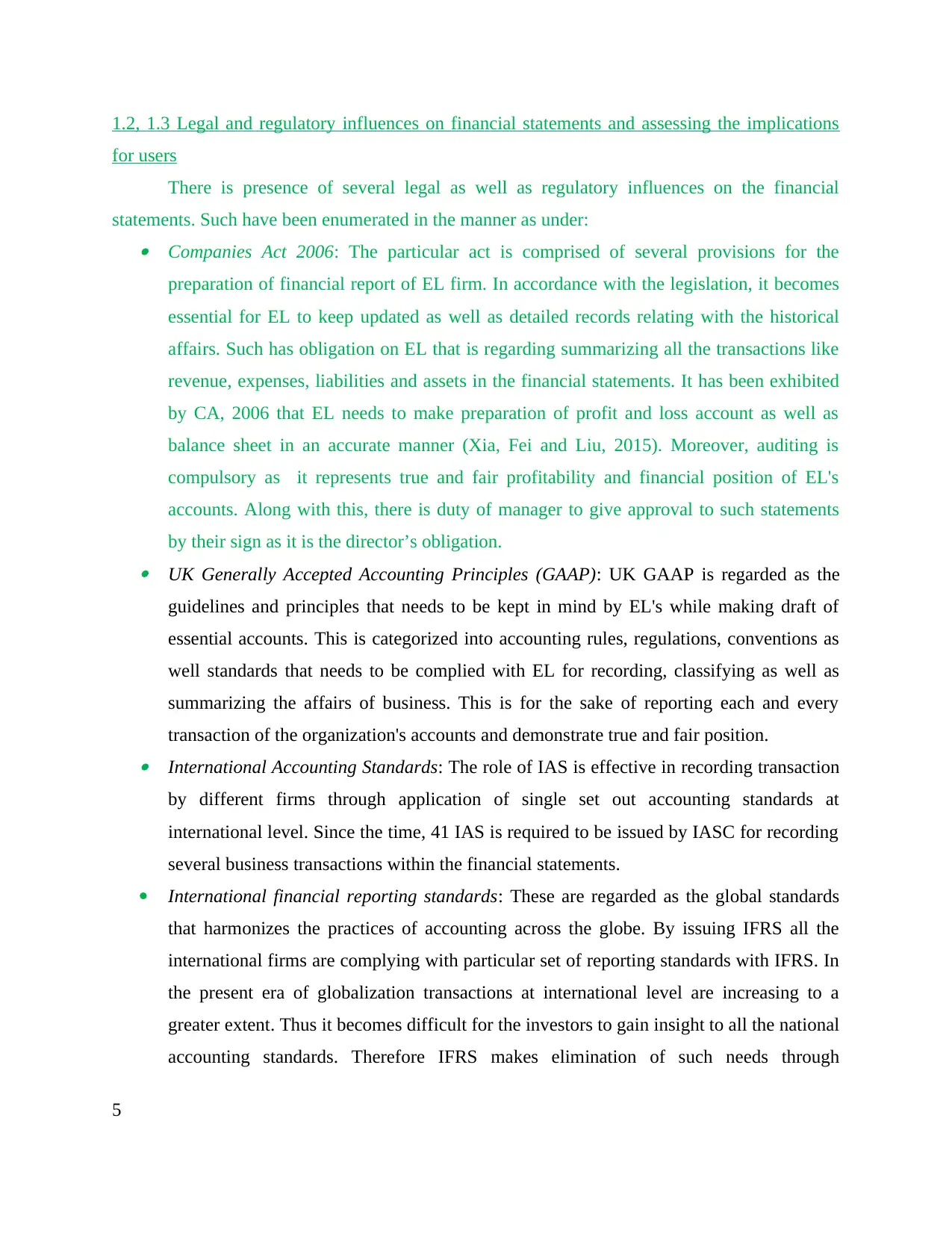
1.2, 1.3 Legal and regulatory influences on financial statements and assessing the implications
for users
There is presence of several legal as well as regulatory influences on the financial
statements. Such have been enumerated in the manner as under: Companies Act 2006: The particular act is comprised of several provisions for the
preparation of financial report of EL firm. In accordance with the legislation, it becomes
essential for EL to keep updated as well as detailed records relating with the historical
affairs. Such has obligation on EL that is regarding summarizing all the transactions like
revenue, expenses, liabilities and assets in the financial statements. It has been exhibited
by CA, 2006 that EL needs to make preparation of profit and loss account as well as
balance sheet in an accurate manner (Xia, Fei and Liu, 2015). Moreover, auditing is
compulsory as it represents true and fair profitability and financial position of EL's
accounts. Along with this, there is duty of manager to give approval to such statements
by their sign as it is the director’s obligation. UK Generally Accepted Accounting Principles (GAAP): UK GAAP is regarded as the
guidelines and principles that needs to be kept in mind by EL's while making draft of
essential accounts. This is categorized into accounting rules, regulations, conventions as
well standards that needs to be complied with EL for recording, classifying as well as
summarizing the affairs of business. This is for the sake of reporting each and every
transaction of the organization's accounts and demonstrate true and fair position. International Accounting Standards: The role of IAS is effective in recording transaction
by different firms through application of single set out accounting standards at
international level. Since the time, 41 IAS is required to be issued by IASC for recording
several business transactions within the financial statements.
International financial reporting standards: These are regarded as the global standards
that harmonizes the practices of accounting across the globe. By issuing IFRS all the
international firms are complying with particular set of reporting standards with IFRS. In
the present era of globalization transactions at international level are increasing to a
greater extent. Thus it becomes difficult for the investors to gain insight to all the national
accounting standards. Therefore IFRS makes elimination of such needs through
5
for users
There is presence of several legal as well as regulatory influences on the financial
statements. Such have been enumerated in the manner as under: Companies Act 2006: The particular act is comprised of several provisions for the
preparation of financial report of EL firm. In accordance with the legislation, it becomes
essential for EL to keep updated as well as detailed records relating with the historical
affairs. Such has obligation on EL that is regarding summarizing all the transactions like
revenue, expenses, liabilities and assets in the financial statements. It has been exhibited
by CA, 2006 that EL needs to make preparation of profit and loss account as well as
balance sheet in an accurate manner (Xia, Fei and Liu, 2015). Moreover, auditing is
compulsory as it represents true and fair profitability and financial position of EL's
accounts. Along with this, there is duty of manager to give approval to such statements
by their sign as it is the director’s obligation. UK Generally Accepted Accounting Principles (GAAP): UK GAAP is regarded as the
guidelines and principles that needs to be kept in mind by EL's while making draft of
essential accounts. This is categorized into accounting rules, regulations, conventions as
well standards that needs to be complied with EL for recording, classifying as well as
summarizing the affairs of business. This is for the sake of reporting each and every
transaction of the organization's accounts and demonstrate true and fair position. International Accounting Standards: The role of IAS is effective in recording transaction
by different firms through application of single set out accounting standards at
international level. Since the time, 41 IAS is required to be issued by IASC for recording
several business transactions within the financial statements.
International financial reporting standards: These are regarded as the global standards
that harmonizes the practices of accounting across the globe. By issuing IFRS all the
international firms are complying with particular set of reporting standards with IFRS. In
the present era of globalization transactions at international level are increasing to a
greater extent. Thus it becomes difficult for the investors to gain insight to all the national
accounting standards. Therefore IFRS makes elimination of such needs through
5
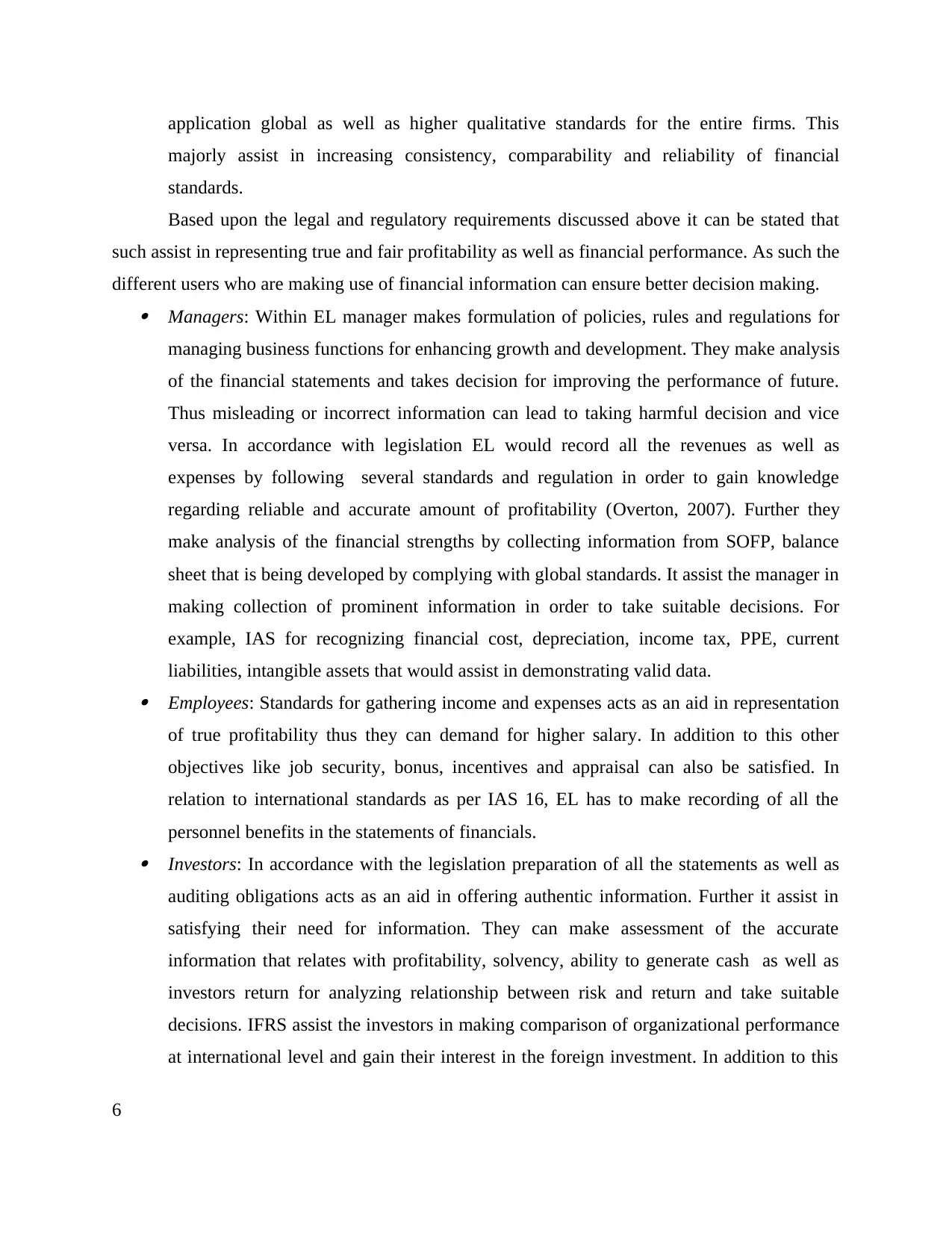
application global as well as higher qualitative standards for the entire firms. This
majorly assist in increasing consistency, comparability and reliability of financial
standards.
Based upon the legal and regulatory requirements discussed above it can be stated that
such assist in representing true and fair profitability as well as financial performance. As such the
different users who are making use of financial information can ensure better decision making. Managers: Within EL manager makes formulation of policies, rules and regulations for
managing business functions for enhancing growth and development. They make analysis
of the financial statements and takes decision for improving the performance of future.
Thus misleading or incorrect information can lead to taking harmful decision and vice
versa. In accordance with legislation EL would record all the revenues as well as
expenses by following several standards and regulation in order to gain knowledge
regarding reliable and accurate amount of profitability (Overton, 2007). Further they
make analysis of the financial strengths by collecting information from SOFP, balance
sheet that is being developed by complying with global standards. It assist the manager in
making collection of prominent information in order to take suitable decisions. For
example, IAS for recognizing financial cost, depreciation, income tax, PPE, current
liabilities, intangible assets that would assist in demonstrating valid data. Employees: Standards for gathering income and expenses acts as an aid in representation
of true profitability thus they can demand for higher salary. In addition to this other
objectives like job security, bonus, incentives and appraisal can also be satisfied. In
relation to international standards as per IAS 16, EL has to make recording of all the
personnel benefits in the statements of financials. Investors: In accordance with the legislation preparation of all the statements as well as
auditing obligations acts as an aid in offering authentic information. Further it assist in
satisfying their need for information. They can make assessment of the accurate
information that relates with profitability, solvency, ability to generate cash as well as
investors return for analyzing relationship between risk and return and take suitable
decisions. IFRS assist the investors in making comparison of organizational performance
at international level and gain their interest in the foreign investment. In addition to this
6
majorly assist in increasing consistency, comparability and reliability of financial
standards.
Based upon the legal and regulatory requirements discussed above it can be stated that
such assist in representing true and fair profitability as well as financial performance. As such the
different users who are making use of financial information can ensure better decision making. Managers: Within EL manager makes formulation of policies, rules and regulations for
managing business functions for enhancing growth and development. They make analysis
of the financial statements and takes decision for improving the performance of future.
Thus misleading or incorrect information can lead to taking harmful decision and vice
versa. In accordance with legislation EL would record all the revenues as well as
expenses by following several standards and regulation in order to gain knowledge
regarding reliable and accurate amount of profitability (Overton, 2007). Further they
make analysis of the financial strengths by collecting information from SOFP, balance
sheet that is being developed by complying with global standards. It assist the manager in
making collection of prominent information in order to take suitable decisions. For
example, IAS for recognizing financial cost, depreciation, income tax, PPE, current
liabilities, intangible assets that would assist in demonstrating valid data. Employees: Standards for gathering income and expenses acts as an aid in representation
of true profitability thus they can demand for higher salary. In addition to this other
objectives like job security, bonus, incentives and appraisal can also be satisfied. In
relation to international standards as per IAS 16, EL has to make recording of all the
personnel benefits in the statements of financials. Investors: In accordance with the legislation preparation of all the statements as well as
auditing obligations acts as an aid in offering authentic information. Further it assist in
satisfying their need for information. They can make assessment of the accurate
information that relates with profitability, solvency, ability to generate cash as well as
investors return for analyzing relationship between risk and return and take suitable
decisions. IFRS assist the investors in making comparison of organizational performance
at international level and gain their interest in the foreign investment. In addition to this
6
⊘ This is a preview!⊘
Do you want full access?
Subscribe today to unlock all pages.

Trusted by 1+ million students worldwide
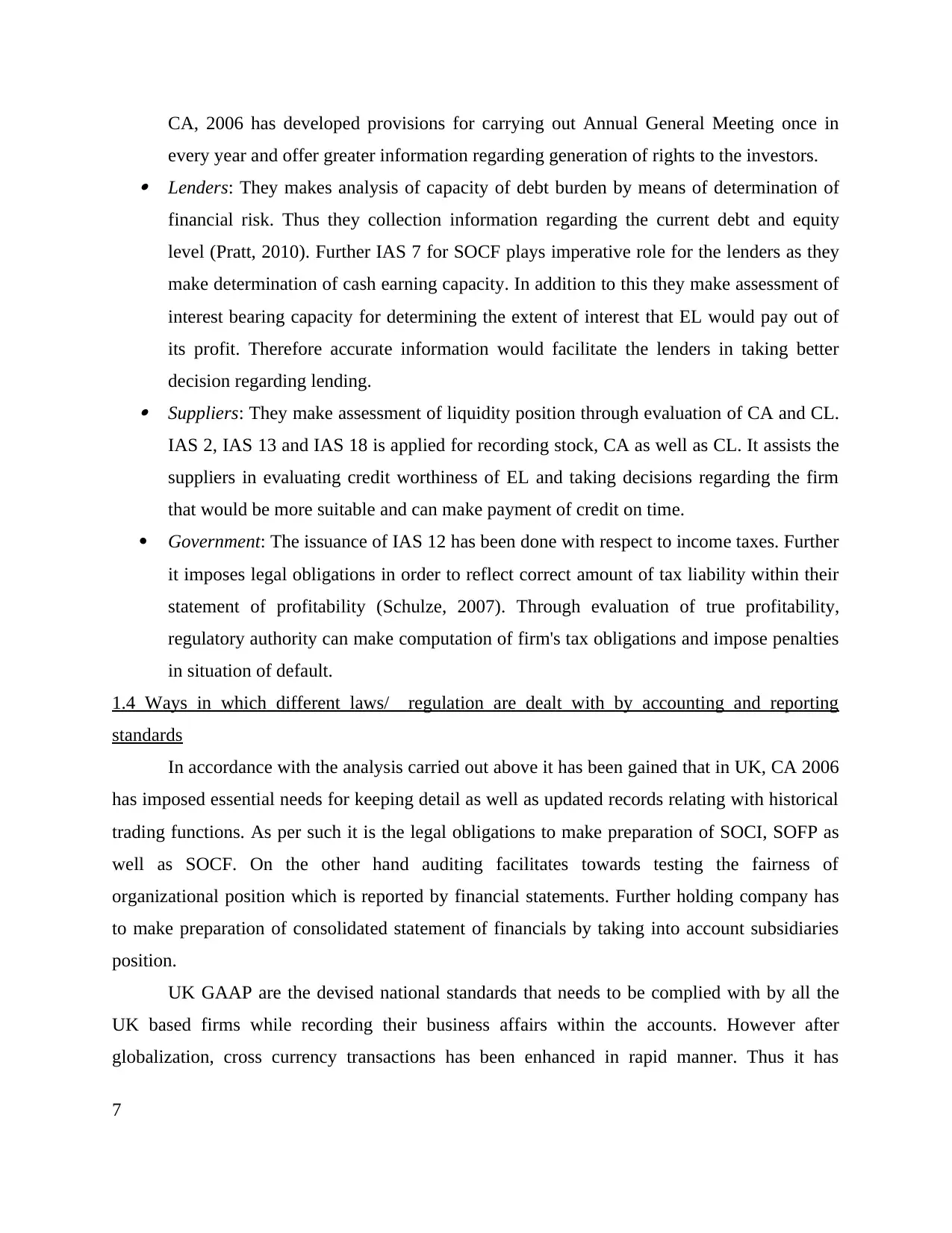
CA, 2006 has developed provisions for carrying out Annual General Meeting once in
every year and offer greater information regarding generation of rights to the investors. Lenders: They makes analysis of capacity of debt burden by means of determination of
financial risk. Thus they collection information regarding the current debt and equity
level (Pratt, 2010). Further IAS 7 for SOCF plays imperative role for the lenders as they
make determination of cash earning capacity. In addition to this they make assessment of
interest bearing capacity for determining the extent of interest that EL would pay out of
its profit. Therefore accurate information would facilitate the lenders in taking better
decision regarding lending. Suppliers: They make assessment of liquidity position through evaluation of CA and CL.
IAS 2, IAS 13 and IAS 18 is applied for recording stock, CA as well as CL. It assists the
suppliers in evaluating credit worthiness of EL and taking decisions regarding the firm
that would be more suitable and can make payment of credit on time.
Government: The issuance of IAS 12 has been done with respect to income taxes. Further
it imposes legal obligations in order to reflect correct amount of tax liability within their
statement of profitability (Schulze, 2007). Through evaluation of true profitability,
regulatory authority can make computation of firm's tax obligations and impose penalties
in situation of default.
1.4 Ways in which different laws/ regulation are dealt with by accounting and reporting
standards
In accordance with the analysis carried out above it has been gained that in UK, CA 2006
has imposed essential needs for keeping detail as well as updated records relating with historical
trading functions. As per such it is the legal obligations to make preparation of SOCI, SOFP as
well as SOCF. On the other hand auditing facilitates towards testing the fairness of
organizational position which is reported by financial statements. Further holding company has
to make preparation of consolidated statement of financials by taking into account subsidiaries
position.
UK GAAP are the devised national standards that needs to be complied with by all the
UK based firms while recording their business affairs within the accounts. However after
globalization, cross currency transactions has been enhanced in rapid manner. Thus it has
7
every year and offer greater information regarding generation of rights to the investors. Lenders: They makes analysis of capacity of debt burden by means of determination of
financial risk. Thus they collection information regarding the current debt and equity
level (Pratt, 2010). Further IAS 7 for SOCF plays imperative role for the lenders as they
make determination of cash earning capacity. In addition to this they make assessment of
interest bearing capacity for determining the extent of interest that EL would pay out of
its profit. Therefore accurate information would facilitate the lenders in taking better
decision regarding lending. Suppliers: They make assessment of liquidity position through evaluation of CA and CL.
IAS 2, IAS 13 and IAS 18 is applied for recording stock, CA as well as CL. It assists the
suppliers in evaluating credit worthiness of EL and taking decisions regarding the firm
that would be more suitable and can make payment of credit on time.
Government: The issuance of IAS 12 has been done with respect to income taxes. Further
it imposes legal obligations in order to reflect correct amount of tax liability within their
statement of profitability (Schulze, 2007). Through evaluation of true profitability,
regulatory authority can make computation of firm's tax obligations and impose penalties
in situation of default.
1.4 Ways in which different laws/ regulation are dealt with by accounting and reporting
standards
In accordance with the analysis carried out above it has been gained that in UK, CA 2006
has imposed essential needs for keeping detail as well as updated records relating with historical
trading functions. As per such it is the legal obligations to make preparation of SOCI, SOFP as
well as SOCF. On the other hand auditing facilitates towards testing the fairness of
organizational position which is reported by financial statements. Further holding company has
to make preparation of consolidated statement of financials by taking into account subsidiaries
position.
UK GAAP are the devised national standards that needs to be complied with by all the
UK based firms while recording their business affairs within the accounts. However after
globalization, cross currency transactions has been enhanced in rapid manner. Thus it has
7
Paraphrase This Document
Need a fresh take? Get an instant paraphrase of this document with our AI Paraphraser
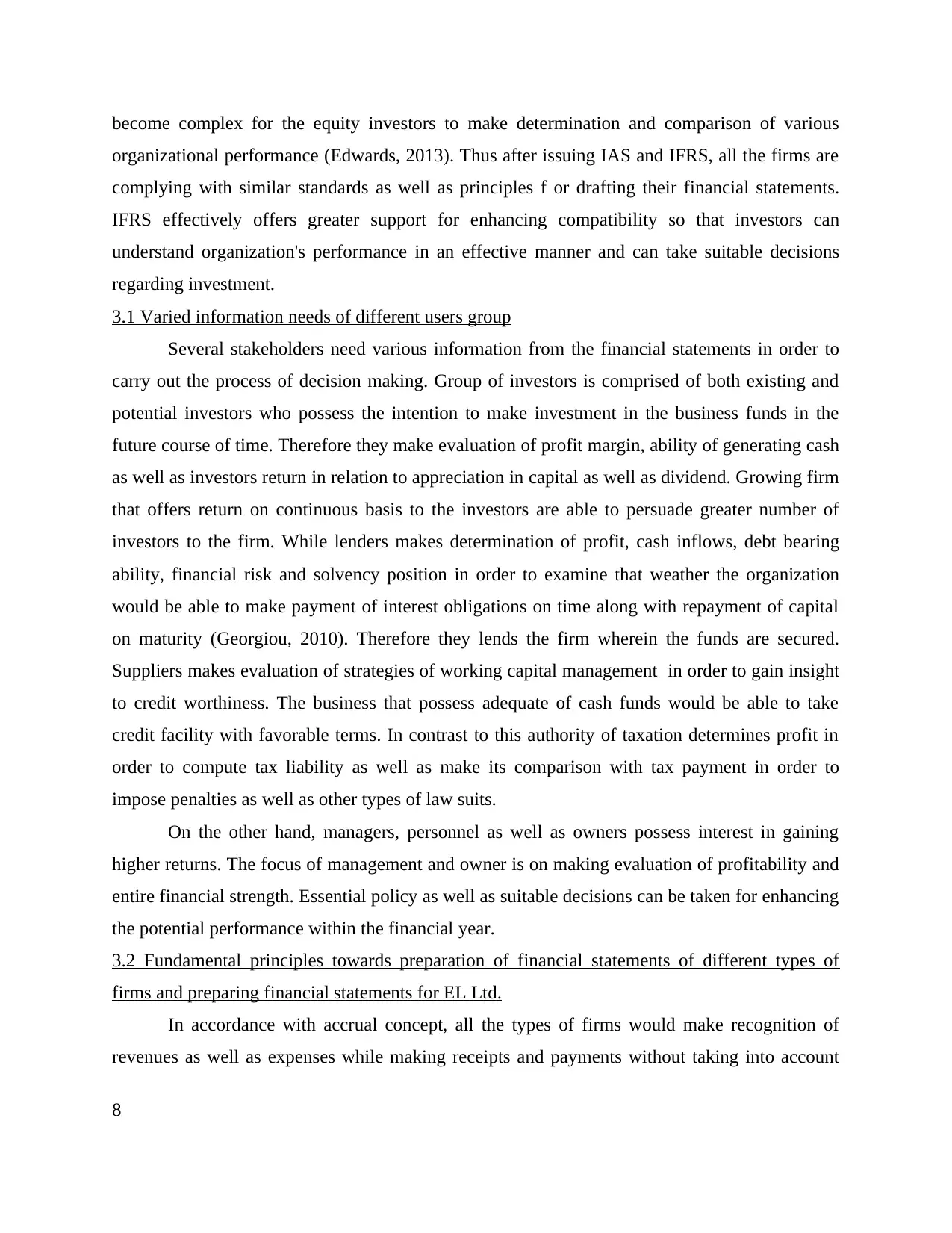
become complex for the equity investors to make determination and comparison of various
organizational performance (Edwards, 2013). Thus after issuing IAS and IFRS, all the firms are
complying with similar standards as well as principles f or drafting their financial statements.
IFRS effectively offers greater support for enhancing compatibility so that investors can
understand organization's performance in an effective manner and can take suitable decisions
regarding investment.
3.1 Varied information needs of different users group
Several stakeholders need various information from the financial statements in order to
carry out the process of decision making. Group of investors is comprised of both existing and
potential investors who possess the intention to make investment in the business funds in the
future course of time. Therefore they make evaluation of profit margin, ability of generating cash
as well as investors return in relation to appreciation in capital as well as dividend. Growing firm
that offers return on continuous basis to the investors are able to persuade greater number of
investors to the firm. While lenders makes determination of profit, cash inflows, debt bearing
ability, financial risk and solvency position in order to examine that weather the organization
would be able to make payment of interest obligations on time along with repayment of capital
on maturity (Georgiou, 2010). Therefore they lends the firm wherein the funds are secured.
Suppliers makes evaluation of strategies of working capital management in order to gain insight
to credit worthiness. The business that possess adequate of cash funds would be able to take
credit facility with favorable terms. In contrast to this authority of taxation determines profit in
order to compute tax liability as well as make its comparison with tax payment in order to
impose penalties as well as other types of law suits.
On the other hand, managers, personnel as well as owners possess interest in gaining
higher returns. The focus of management and owner is on making evaluation of profitability and
entire financial strength. Essential policy as well as suitable decisions can be taken for enhancing
the potential performance within the financial year.
3.2 Fundamental principles towards preparation of financial statements of different types of
firms and preparing financial statements for EL Ltd.
In accordance with accrual concept, all the types of firms would make recognition of
revenues as well as expenses while making receipts and payments without taking into account
8
organizational performance (Edwards, 2013). Thus after issuing IAS and IFRS, all the firms are
complying with similar standards as well as principles f or drafting their financial statements.
IFRS effectively offers greater support for enhancing compatibility so that investors can
understand organization's performance in an effective manner and can take suitable decisions
regarding investment.
3.1 Varied information needs of different users group
Several stakeholders need various information from the financial statements in order to
carry out the process of decision making. Group of investors is comprised of both existing and
potential investors who possess the intention to make investment in the business funds in the
future course of time. Therefore they make evaluation of profit margin, ability of generating cash
as well as investors return in relation to appreciation in capital as well as dividend. Growing firm
that offers return on continuous basis to the investors are able to persuade greater number of
investors to the firm. While lenders makes determination of profit, cash inflows, debt bearing
ability, financial risk and solvency position in order to examine that weather the organization
would be able to make payment of interest obligations on time along with repayment of capital
on maturity (Georgiou, 2010). Therefore they lends the firm wherein the funds are secured.
Suppliers makes evaluation of strategies of working capital management in order to gain insight
to credit worthiness. The business that possess adequate of cash funds would be able to take
credit facility with favorable terms. In contrast to this authority of taxation determines profit in
order to compute tax liability as well as make its comparison with tax payment in order to
impose penalties as well as other types of law suits.
On the other hand, managers, personnel as well as owners possess interest in gaining
higher returns. The focus of management and owner is on making evaluation of profitability and
entire financial strength. Essential policy as well as suitable decisions can be taken for enhancing
the potential performance within the financial year.
3.2 Fundamental principles towards preparation of financial statements of different types of
firms and preparing financial statements for EL Ltd.
In accordance with accrual concept, all the types of firms would make recognition of
revenues as well as expenses while making receipts and payments without taking into account
8
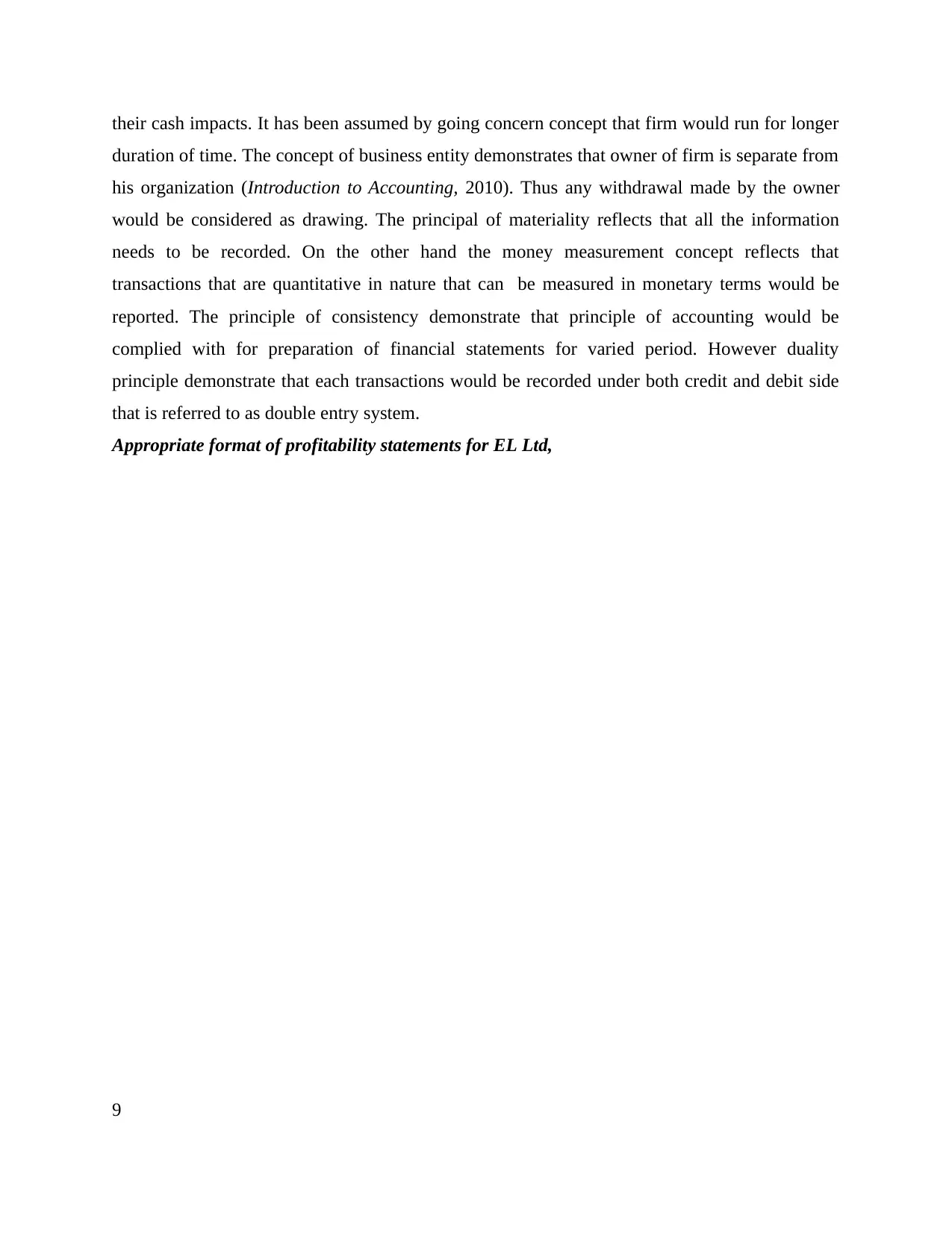
their cash impacts. It has been assumed by going concern concept that firm would run for longer
duration of time. The concept of business entity demonstrates that owner of firm is separate from
his organization (Introduction to Accounting, 2010). Thus any withdrawal made by the owner
would be considered as drawing. The principal of materiality reflects that all the information
needs to be recorded. On the other hand the money measurement concept reflects that
transactions that are quantitative in nature that can be measured in monetary terms would be
reported. The principle of consistency demonstrate that principle of accounting would be
complied with for preparation of financial statements for varied period. However duality
principle demonstrate that each transactions would be recorded under both credit and debit side
that is referred to as double entry system.
Appropriate format of profitability statements for EL Ltd,
9
duration of time. The concept of business entity demonstrates that owner of firm is separate from
his organization (Introduction to Accounting, 2010). Thus any withdrawal made by the owner
would be considered as drawing. The principal of materiality reflects that all the information
needs to be recorded. On the other hand the money measurement concept reflects that
transactions that are quantitative in nature that can be measured in monetary terms would be
reported. The principle of consistency demonstrate that principle of accounting would be
complied with for preparation of financial statements for varied period. However duality
principle demonstrate that each transactions would be recorded under both credit and debit side
that is referred to as double entry system.
Appropriate format of profitability statements for EL Ltd,
9
⊘ This is a preview!⊘
Do you want full access?
Subscribe today to unlock all pages.

Trusted by 1+ million students worldwide
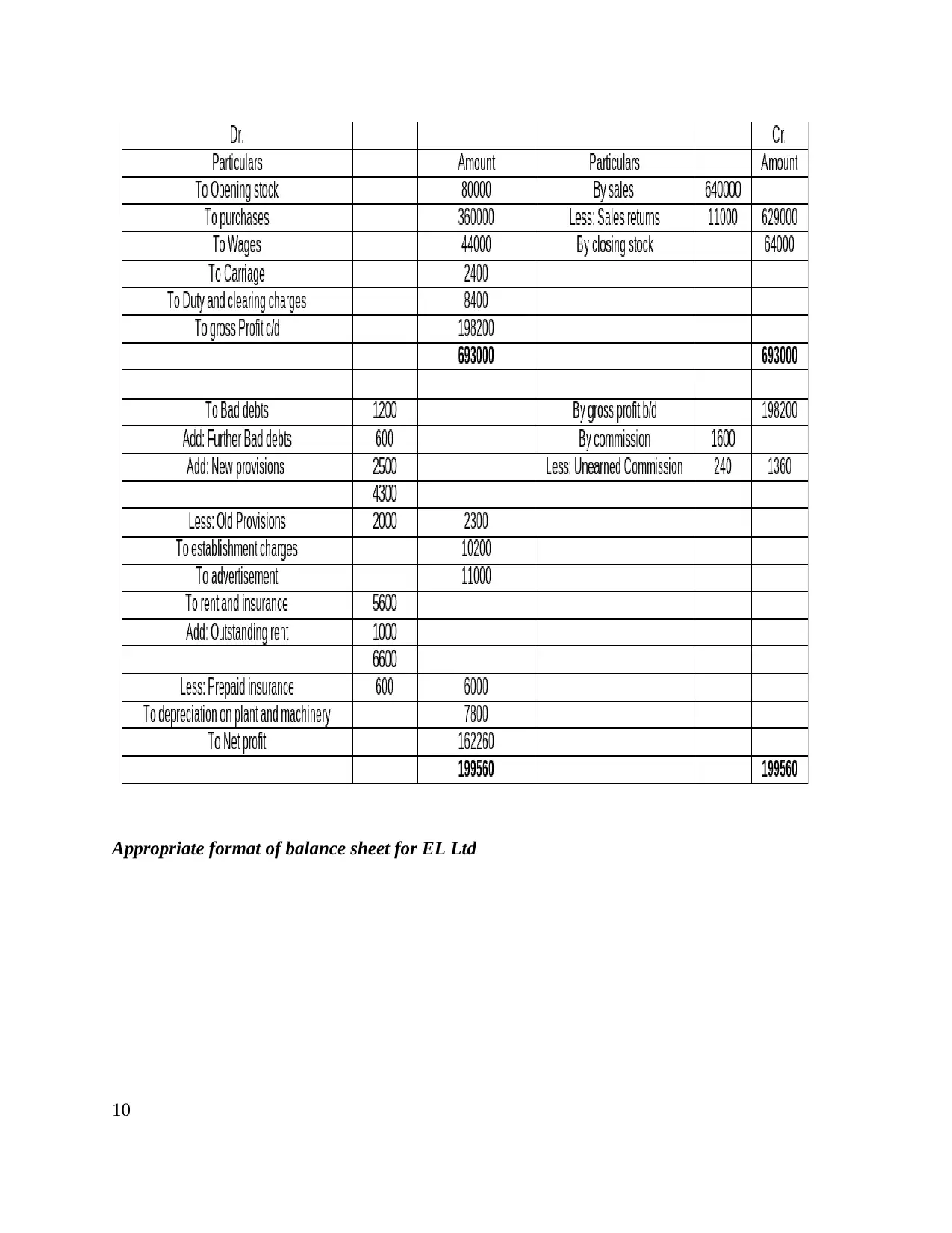
Appropriate format of balance sheet for EL Ltd
10
10
Paraphrase This Document
Need a fresh take? Get an instant paraphrase of this document with our AI Paraphraser
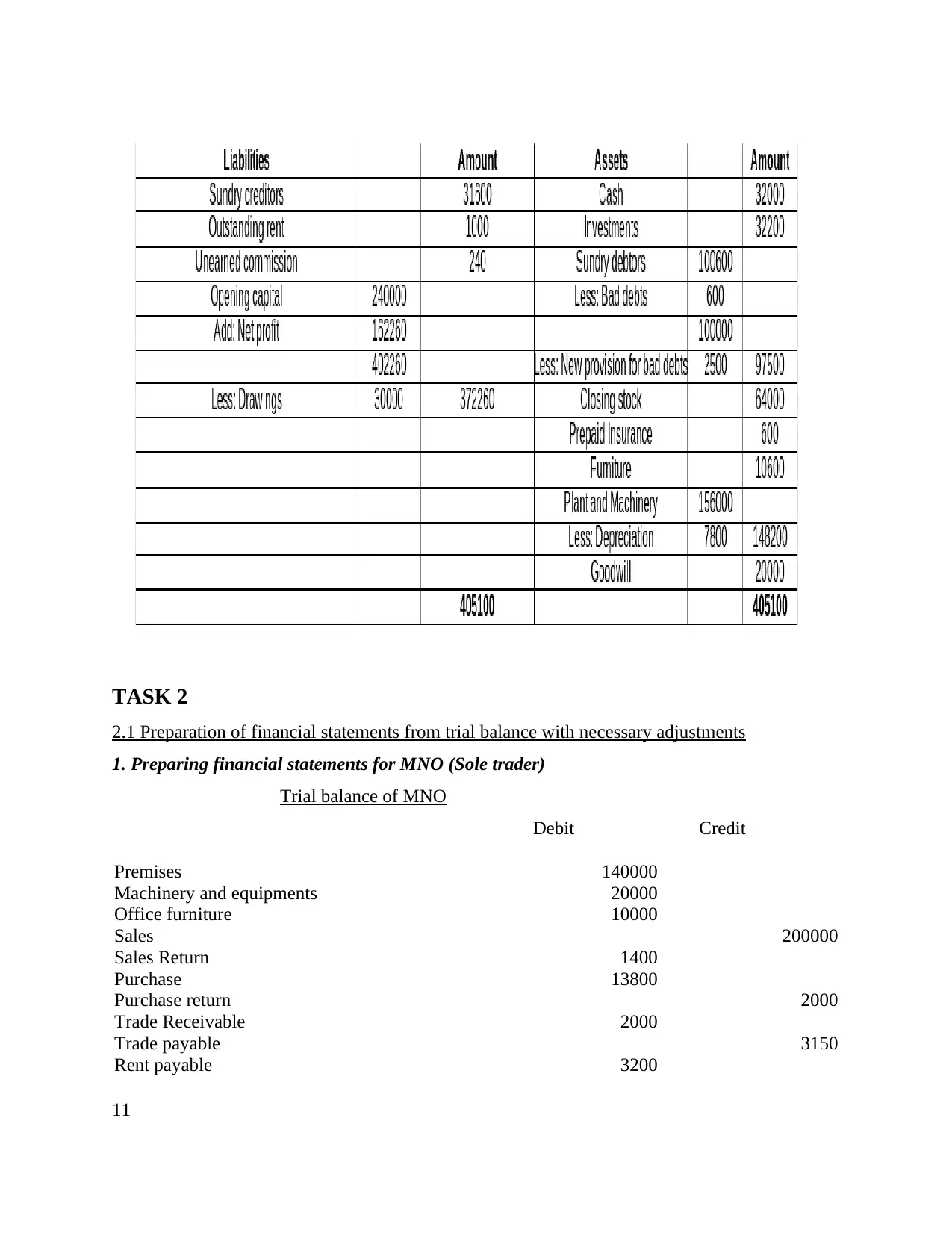
TASK 2
2.1 Preparation of financial statements from trial balance with necessary adjustments
1. Preparing financial statements for MNO (Sole trader)
Trial balance of MNO
Debit Credit
Premises 140000
Machinery and equipments 20000
Office furniture 10000
Sales 200000
Sales Return 1400
Purchase 13800
Purchase return 2000
Trade Receivable 2000
Trade payable 3150
Rent payable 3200
11
2.1 Preparation of financial statements from trial balance with necessary adjustments
1. Preparing financial statements for MNO (Sole trader)
Trial balance of MNO
Debit Credit
Premises 140000
Machinery and equipments 20000
Office furniture 10000
Sales 200000
Sales Return 1400
Purchase 13800
Purchase return 2000
Trade Receivable 2000
Trade payable 3150
Rent payable 3200
11
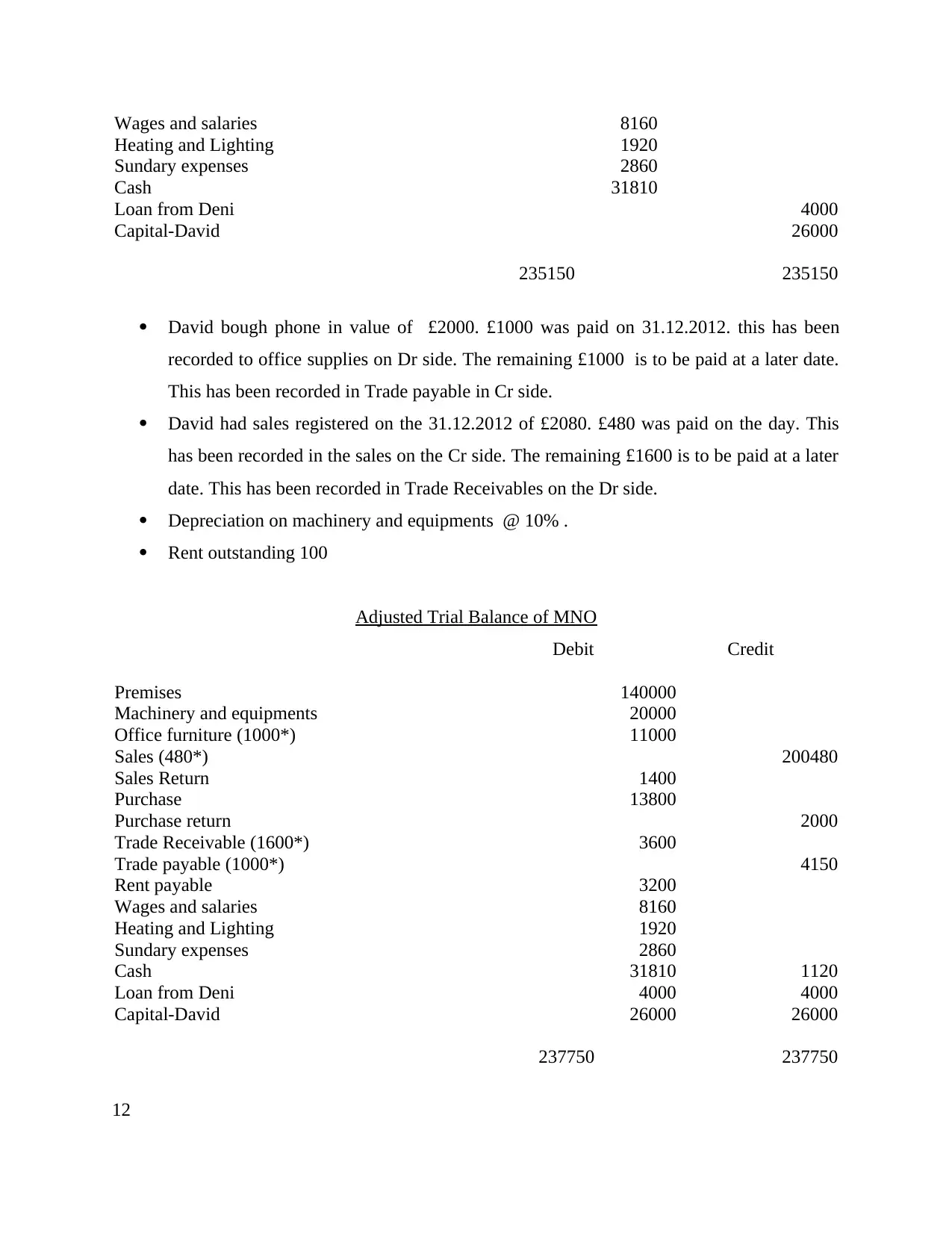
Wages and salaries 8160
Heating and Lighting 1920
Sundary expenses 2860
Cash 31810
Loan from Deni 4000
Capital-David 26000
235150 235150
David bough phone in value of £2000. £1000 was paid on 31.12.2012. this has been
recorded to office supplies on Dr side. The remaining £1000 is to be paid at a later date.
This has been recorded in Trade payable in Cr side.
David had sales registered on the 31.12.2012 of £2080. £480 was paid on the day. This
has been recorded in the sales on the Cr side. The remaining £1600 is to be paid at a later
date. This has been recorded in Trade Receivables on the Dr side.
Depreciation on machinery and equipments @ 10% .
Rent outstanding 100
Adjusted Trial Balance of MNO
Debit Credit
Premises 140000
Machinery and equipments 20000
Office furniture (1000*) 11000
Sales (480*) 200480
Sales Return 1400
Purchase 13800
Purchase return 2000
Trade Receivable (1600*) 3600
Trade payable (1000*) 4150
Rent payable 3200
Wages and salaries 8160
Heating and Lighting 1920
Sundary expenses 2860
Cash 31810 1120
Loan from Deni 4000 4000
Capital-David 26000 26000
237750 237750
12
Heating and Lighting 1920
Sundary expenses 2860
Cash 31810
Loan from Deni 4000
Capital-David 26000
235150 235150
David bough phone in value of £2000. £1000 was paid on 31.12.2012. this has been
recorded to office supplies on Dr side. The remaining £1000 is to be paid at a later date.
This has been recorded in Trade payable in Cr side.
David had sales registered on the 31.12.2012 of £2080. £480 was paid on the day. This
has been recorded in the sales on the Cr side. The remaining £1600 is to be paid at a later
date. This has been recorded in Trade Receivables on the Dr side.
Depreciation on machinery and equipments @ 10% .
Rent outstanding 100
Adjusted Trial Balance of MNO
Debit Credit
Premises 140000
Machinery and equipments 20000
Office furniture (1000*) 11000
Sales (480*) 200480
Sales Return 1400
Purchase 13800
Purchase return 2000
Trade Receivable (1600*) 3600
Trade payable (1000*) 4150
Rent payable 3200
Wages and salaries 8160
Heating and Lighting 1920
Sundary expenses 2860
Cash 31810 1120
Loan from Deni 4000 4000
Capital-David 26000 26000
237750 237750
12
⊘ This is a preview!⊘
Do you want full access?
Subscribe today to unlock all pages.

Trusted by 1+ million students worldwide
1 out of 23
Related Documents
Your All-in-One AI-Powered Toolkit for Academic Success.
+13062052269
info@desklib.com
Available 24*7 on WhatsApp / Email
![[object Object]](/_next/static/media/star-bottom.7253800d.svg)
Unlock your academic potential
Copyright © 2020–2025 A2Z Services. All Rights Reserved. Developed and managed by ZUCOL.





